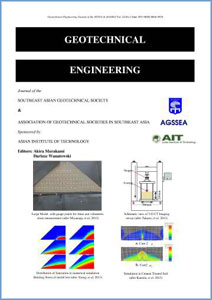Modeling and bending test simulations of cement treated soil
Main Article Content
Abstract
Cement treated soil, which is commonly utilized to prevent liquefaction and/or to increase the bearing capacity of soft clay foundations, is characterized by four basic properties: 1) its strength is greater than that of untreated soil, yet less than that of concrete, 2) it exhibits nonlinear behavior close to its peak strength, 3) softening occurs after its peak strength has been exceeded, and 4) the extension strength is found while the soil is not considered. In this study, the subloading surface model introduced by Hashiguchi was incorporated into a modified Drucker-Prager criterion, and undrained triaxial compression tests of cement treated soil were performed under constrained pressures of 0.1 and 0.4 MN/m2, after which bending tests and simulations were performed. The numerical results of these tests agreed well with the actual results of element wise and boundary condition testing.
Article Details

This work is licensed under a Creative Commons Attribution-NonCommercial-NoDerivatives 4.0 International License.
Copyright © 2019 Association of Geotechnical Societies in Southeast Asia (AGSSEA) - Southeast Asian Geotechnical Society (SEAGS).


